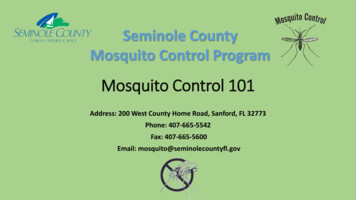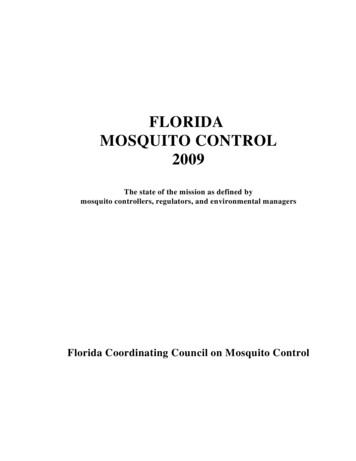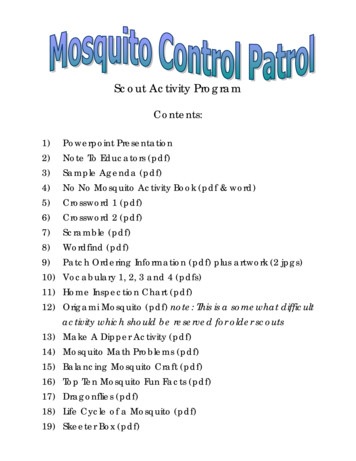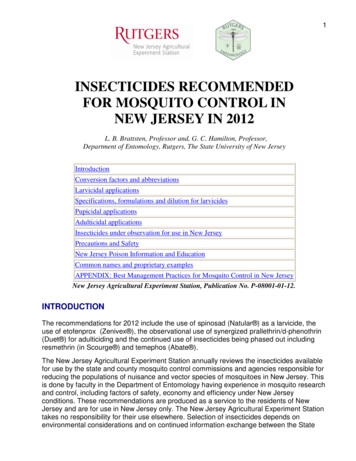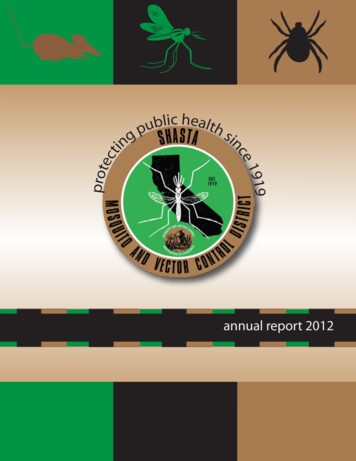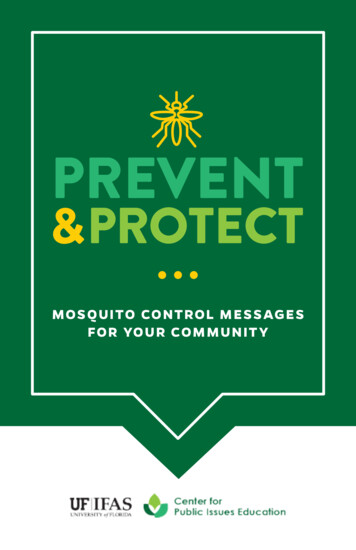
Transcription
MOSQUITO CONTROL M ESSAG ESFOR YO UR COM MUN IT Y
INTRODUCINGMOS Q UITO CONTROL M ESSAG ESFOR YO UR COM MUN IT YPrevent & Protect is a resource for Florida’s local officials toeffectively communicate about mosquito management to ourstate’s citizens. The UF/IFAS Center for Public Issues Education inAgriculture and Natural Resources (PIE Center), as part of a FloridaDepartment of Health grant, created the Prevent & Protect resourceto help local officials communicate to residents of Florida’s cities andcounties about the importance of mosquito control efforts and howresidents can help reduce mosquito populations.INTHISGUIDEMosquitoes cannegatively impact yourcommunity’s health,economy and enjoymentof the outdoors. Learnhow to communicateabout these issues in thisguide.In this guide, you will learn how to use two toolkits designed to educateyour community about mosquito control. Each toolkit has pre-made socialmedia posts and graphics that are easy to use to inform the public about theimportance of mosquito control. The Mosquito Control Toolkit is intended toeducate the public on mosquito control and the negative impact mosquitoescan have in your community. There are four parts to the Prevent & Protecttoolkit: personal responsibility, mosquito-borne illnesses, nuisance andeconomy, and application method. The Emergency Response Toolkit isdesigned to educate the public about mosquito control emergency responseactions, primarily after a hurricane or flood and during a disease outbreak.The UF/IFAS PIE Center conducts research and educateson how people form and act on opinions regardingcomplex agricultural and natural resources issues.Both toolkits include social media content with suggestions on when topublish each post, as well as instructions on how to download the componentsand customize each item to best fit your mosquito control educational efforts.The content in this guide was created with research from focus groups, aprofessional panel and academic publications.23
MOSQUITO CONTROLToolkit IndexWeek SummariesIn this toolkit, you will find:Week One: Personal ResponsibilityThis week’s messages and posts encourage the public to takepreventive measures to protect themselves and their families frommosquito-borne diseases. Goal: Inform the public that they playa vital role in protecting themselves and their community frommosquito-borne diseases.Social Media Posts: Pre-made graphics accompanied by text, readyfor you to post to your social media pages. (pp. 6-7)Infographics: Use colorful images and text to display information soreaders can better understand mosquito control messages. (pp. 8-9)Info-sheets: Use text to display information so readers can betterunderstand mosquito control messages. (pp. 10-11)Characters: Dr. Diaz and Brad are used in the campaign to show howmosquitoes impact health and how operators control populations.(pp. 12-15)Key Recommendations: Recommendations for effectivecommunication on mosquito control based on our research. (p.16)Frequently Asked Questions: Answers to frequently asked questionsregarding mosquito control. (p. 17)Instructions: Instructions on how to download both toolkits andcustomize to add your organization’s logo, if desired. (pp. 18-19)4MOSQUITO CONTROLWeek Two: Mosquito-Borne IllnessThis week’s messages and posts educate the public on theimportance of combatting diseases transmitted by mosquitoes.Goal: Inform the public that mosquito control is necessary becauseof the threat of diseases transmitted by mosquitoes.Week Three: Nuisance and EconomyThis week’s messages and posts inform the public on the negativeeffects mosquitoes have on Florida’s economy and the public’sability to enjoy outdoor activities. Tourists are less likely to visit anarea with nuisance mosquitoes, and even less likely to visit an areawith known mosquito-borne illnesses. Goal: Inform the public thatmosquitoes can have a negative impact on tourism, healthcare andthe livestock industry in Florida, which all impact the welfare ofFlorida’s residents and Florida’s economy.Week Four: Application MethodsThis week’s messages and posts explain the application methodsused by mosquito control programs to control mosquito populations.Operators use a treatment method called integrated mosquitomanagement (IMM) to treat mosquito populations. Operators usetheir understanding of mosquito biology to decide which stepof IMM is appropriate for affected areas. Goal: Inform the publicthat mosquito control protects the public from disease outbreaks,reduces nuisance mosquitoes and protects Florida’s economy.5
MOSQUITO CONTROLSocial MediaMOSQUITO CONTROLSocial MediaThe Mosquito Control Toolkit provides social media posts readyfor you to publish to your organization’s social media accounts.The posts are categorized into four weeks: personal responsibility,mosquito-borne diseases, nuisance and economy, and applicationmethods. Each week has a variety of posts. Every post has a graphicpaired with an accompanied text. People are more likely to readposts that contain graphics than posts without graphics.Social media is a great way to reach a diverse audience. The contentin this toolkit is formatted to be educational and understandable forHere is an example of a post from week three (nuisance andthe general public.economy), educating the public on the relationship betweenmosquitoes and warm areas.Visit piecenter.com/mosquito to view all social media content andgraphics and to download your own.Use the project’s name “Prevent & Protect” inevery post to unify branding.6Here is an example of a post from week two (mosquito-bornediseases), testing the public on their knowledge of mosquito-bornediseases.7
MOSQUITO CONTROLInfographics & Rack CardsMOSQUITO CONTROLInfographics & Rack CardsThe Mosquito Control Toolkit also contains several infographics thatW HAT YOU C A N D OTO H ELP ELI M I NATEMOS Q UITOES ATYO UR HOM Ecan be used to educate your audience about mosquito control. Thetopic of personal responsibility was chosen because our researchdetermined that Floridians want to know what they can do to helpMosquitoes can live indoors andwill bite at any time, day or nightthe process, which can lead to public concern.Infographics display important information alongside colorful imagesin order to catch the reader’s eye and help them better understandUse airconditioningInsecticides used for aerialtreatment have been studiedfor their effectiveness andsafety. The small amountthat is used to treat is notexpected to pose a healthrisk for people or pets!Keep screenson all windowsAerial treatment is the preferred method forinsecticide when people are getting sick withviruses like Zika, Dengue, or West NileRepair anyripped screensSTOP THEMFROMBREEDINGMosquitoes breed by laying eggsin and near standing waterYou do not need to do anything to preparefor aerial treatmentPut away itemsthat are outsideand not being usedAerial treatment is just one way to helpcontrol mosquitoesAerial treatment quickly reduces the numberof mosquitoes in an area, but does notprovide long-lasting mosquito control.Flush outwater-holding plantswith a hose once a weekOnce a week, empty, turnover or cover anythingthat could hold waterwhat is trying to be communicated.8.5 inchesas a topic because research showed that people are uninformed onKEEPTHEMOUTSIDE11 inchesprotect themselves from mosquitoes. Aerial application was chosenUSI NG A ERIA L TRE ATM ENT FORMOSQ UITO CONTROLKeep doors andwindows shutThis publication was produced with fundingprovided by the Florida Department of Health.3.5 inchesThis publication was produced with fundingprovided by the Florida Department of Health.8.5 inchesThe infographics are provided in two size formats: 8.5 x 11 inchesand 3.5 x 8.5 inches. These infographics can be used as resourcesfor social media posts. The 8.5 x 11 inches infographic can be easilyUSI NGA ERIALTR E ATM ENTFOR MOSQUITOCONTROLprinted at home or in the office. The 3.5 x 8.5 inches infographic,as a rack card, can be used as an educational handout from yourWhen airplanes are used to treat a large area witha very small amount of insecticide to kill eitherthe mosquito larvae that hatch from eggs oradult mosquitoes, it’s called an aerial treatment.When conducted according to regulation, aerialtreatment is a safe, quick, and efficient way tohelp control mosquitoes that can carry virusesand make people sick.organization or agency. These would be great to distribute tohomeowners.You can download these infographics to customize the resources atpiecenter.com/mosquito.8During treatment,about 1 ounce(2 tablespoons) ofinsecticide is usedper acre (averagefootball field size)Aerial treatmentis the preferredmethod forinsecticide whenpeople are gettingsick with viruseslike Zika, Dengue,or West NileYou do not needto do anything toprepare for aerialtreatmentWHAT YOU C AN DO TO H ELP ELI M I NATEMOSQUITOES AT YO UR HOM EWHAT YOU C AN DO TO H ELP ELI M I NATEMOSQUITOES AT YO UR HOM EDID YOU KNOW?STOP THEM FROM INCREASINGKEEP THEM OUTSIDEWhen airplanes are used to treat alarge area with a very small amount ofinsecticide to kill either the mosquito larvaethat hatch from eggs or adult mosquitoes,it’s called an aerial treatment. Whenconducted according to regulation, aerialtreatment is a safe, quick, and efficient wayto help control mosquitoes that can carryviruses and make people sick.Mosquitoes breed by laying eggs inand near standing waterPut away items that are outsideand not being usedMosquitoes can live indoors and willbite at any time, day or nightKeep doors and windows shutUse air conditioningFlush out water-holding plantswith a hose once a weekKeep screens on all windowsRepair any ripped screensAerial treatmentis just one wayto help controlmosquitoesInsecticides used for aerialtreatment have been studiedfor their effectiveness andsafety. The small amountthat is used to treat is notexpected to pose a healthrisk for people or pets!This publication was produced with funding provided by the Florida Department of Health.USI NG A ERIA L TRE ATM ENT FORMOSQUITO CONTROLDuring treatment, about 1 ounce(2 tablespoons) of insecticide is usedper acre (average football field size)This publication was produced with fundingprovided by the Florida Department of Health.Once a week, empty, turn over orcover anything that could hold waterThis publication was produced with fundingprovided by the Florida Department of Health.This publication was produced with fundingprovided by the Florida Department of Health.9
MOSQUITO CONTROLMOSQUITO CONTROLInfo-sheetsTwo info-sheets are available for youto use, including one on environmentalimpact of mosquitoes. Our researchidentified these topics as highlyimportant to Floridians.97DID YO U KNOW?While visiting Florida, out-of-state visitorsspend more than 110 billion in a single year.In 2016, more than 875,000 jobs were directlysupported through tourism in Florida. That isone out of every six jobs1.However, Florida’s tourism was not alwaysthis successful. Mosquito populations poseda serious threat to both the livelihood ofFloridians and appeal to visitors. Since the1950s, mosquito population control effortshave reduced the number of mosquitoes inFlorida by more than 90 percent2. Mosquitocontrol has had positive results for the stateof Florida. Not only can 21 million people callFlorida home, millions of tourists can enjoyits parks, cities and beaches without constantworry of nuisance mosquitoes. The control ofmosquitoes leads to increased jobs, revenueand enjoyment.AS FLORIDA’SMOSQ UI TOPOPUL AT I ONDECREASEDdisplay important information that canbe easily understood by the generalImpact of Mosquito Control onHoney BeesD ID YO U K N OW?TO UR IS TSV ISIT FLO R I DA EVER Y Y EARWHILE I N F LO R I DA ,TOURI ST S C A N B E80PESTERED BY ANY OF THESPECIES OFM O S Q U I TO E SFLORI DA’STOURI SMINDUSTRYINCRE ASE DFA I L U R E T O C O N T R O L M O S Q U I T O E S C A N N E G AT I V E LY A F F E C T F L O R I D A’ SScientists at the University of Florida and FloridaDepartment of Agriculture and Consumer Serviceshave researched the impact of mosquito controlon honey bees. Mosquito control that focuses onbreeding habitat and mosquitoes that have notreached adulthood do not pose any significantharm to bees. According to the University of FloridaInstitute of Food and Agricultural Sciences, Bti,a naturally occuring bacterium found in soils, isnot harmful to honey bees when used as a larvaltreatment1.Beekeepers can also temporarily cover coloniesloosely with plywood or a tarp, but use caution tonot completely seal the hive or the honey bees willoverheat. Mosquito control programs can help protectbees by applying aerial treatment at dawn or at duskwhen bees are in their hives. During aerial treatmentfor adult mosquitoes, only 2 tablespoons per acre(approximately the size of a football field) are applied.T R E AT M E N T A P P L I E D ATDAWN OR DUSKCAN REDUCEEXPOSURE TO BEESECONOMY12VISITORSHEALTHLOOSELYCOVER HIVESDURINGT R E AT M E N T SAerial treatment for adult mosquitoes can impactbees outside of their hives; however, there areprecautions beekeepers and mosquito controlprograms can take to protect bees. Bee keepersshould work with their local mosquito control programto stay informed on spraying times and dates2.public. Info-sheets can also be used insocial media content or as material forHOW CAN BEEKEEPERSHELP BEES?S TAYINFORMEDONT R E AT M E N TSCHEDULESWORKWITHMOSQUITOCONTROLPROGRAMS2O N LYSimilar to infographics, info-sheets alsoImpact of Mosquitoes onFlorida’s Economy and TourismMILLIONimpacts and one on the economicInfo-sheetsTA B L E S P O O N SO F A D U LT M O S Q U I T O T R E AT M E N T A R EAPPLIED TO AN AREA THE SIZE OF AFOOTBALL //edis.ifas.ufl.edu/in813educational programming.Visit piecenter.com/mosquito for moreinformation about the Mosquito ControlToolkit and to download the info-sheets.10The first info-sheetThe second info-sheetfocuses on the impact offocuses on the impactmosquitoes on Florida’sof mosquito control oneconomy and tourism.honey bees.11
an important message fromDR. DIAZMOSQUITO CONTROLImportant Health ResourcesCenters for Disease Control and PreventionTwitter: @CDCgovFacebook: @CDCPhone: 1-800-232-4636Florida Department of HealthTwitter: @HealthyFlaFacebook: @FLDeparmentofHealthPhone: (850) 245-4444My name is Dr. Diaz and I am a healthcare provider inEmail: Health@flhealth.govMiami. I care about all of my patients, and want ity to stay safe, especially from htmlborne diseases. There are many mosquito-bornediseases that can harm you and your family, includingZika, West Nile virus, Dengue fever, Yellow fever,Chikungunya, Western equine encephalitis and St. Louisencephalitis. I sometimes treat these diseases, and amsharing this knowledge because I care. Some diseasescan display mild symptoms, while others can be deadly.That is why it is so important to protect you and yourfamily from mosquito-borne diseases by applying EPAand FDACS approved insect repellent, and wearinglong-sleeved shirts and long pants.RESOURCESUse resources from the Centers for Disease Control andPrevention and the Florida Department of Health to answerhealth-related questions you may recieve while communicatingabout mosquito control. Additional resources are available atpiecenter.com/mosquito.12Dr. Diaz is used in this campaign to show the relationship between healthcare anddiseases transmitted by mosquitoes.13
an important message fromBRADMOSQUITO CONTROLImportant Mosquito ResourcesFlorida Department of Agriculture andConsumer Services:Phone: (850) 617-7917Email: to-ControlMy name is Brad and I am a mosquito control operatorin your local moquito control program. I survey ourcommunity for mosquitoes and help prevent emergingmosquito populations from harming your family. Thereare 61 mosquito control programs in Florida that locallycontrol mosquito populations based on IntegratedMosquito Management, just like I do. Based on localenvironments and mosquito biology, mosquito controlprogram operators use a combination of strategiesto protect you and your community. The FloridaDepartment of Agriculture and Consumer ServicesRESOURCESoversees all mosquito control programs. The stateUse resources from the Florida Department of Agriculture andworks with local areas to best protect each communityConsumer Services to answer questions you may receive pertainingin Florida. Together, we protect you and your family.to mosquito control programs while communicating about mosquitocontrol. Additional resources are available on piecenter.com/mosquito for further questions.14Brad is used in this campaign to display the men and women who work in communities tocontrol mosquitoes.15
MOSQUITO CONTROLKey RecommendationsConsistent Message: Whoever the public contacts about mosquitocontrol questions needs to provide a consistent message. If this roleis decentralized currently, we recommend to identify one or twopeople who can be the main information source about mosquitocontrol efforts.Local Media: Provide local reporters with a consistent message.MOSQUITO CONTROLFrequently Asked QuestionsThese are questions you may encounter. Here are some messages that will be helpful toyou. More information is provided at piecenter.com/mosquito/#resourcesIs Naled safe?When used according to regulations set by the United States EPA, Naledis expected to be safe for humans and pets. It is targeted toward flyingmosquitoes and applied to the air in droplets mixed with water. Verylittle amount of the treatment reaches the ground because only 1-2tablespoons are used per acre (length of a football field). It has beenused effectively in Florida since 1959.Partner with them to get information out. To learn more aboutdeveloping a media relations program, please visit http://edis.ifas.ufl.edu/topic media relations.Treatment: If your county has a protocol of when to treat formosquitoes, it is recommended that you consider sharing it withresidents if they request it.Message Points: Use piecenter.com/mosquito for resources onmessage content in the toolkit. There are also frequently askedquestions answered on the next page.16Does mosquito control harm bees?While insecticides used on mosquitoes can kill bees outside of theirhives, treatment that is applied before dawn or after dusk can reduceimpact because bees are usually inside their hives. However, it is notalways appropriate to treat before dawn or after dusk for certainmosquito species. According to the Centers for Disease Controland Prevention, studies show that honey production between hivesin treated and untreated sites did not show significantly differentquantities of honey over the course of a season. Beekeepers andconcerned citizens should work with their local mosquito controlprogram to determine when and where they treat for mosquitoes.Why are you treating our community for mosquitoes?Mosquitoes can transmit diseases, reduce tourism and negativelyimpact our economy. Operators use Integrated Mosquito Management(IMM) when treating our community for mosquitoes. They survey areas,remove breeding sites, use structural barriers, control mosquitoes atthe larval stage (larvicide) and reduce the number of adult mosquitoes(adulticide). Treating adult mosquitoes is an important step of IMM, aprocess that protects you and your family. You can find more resourcesabout mosquito control at piecenter.com/mosquito/#resources.17
MOSQUITO CONTROLMOSQUITO CONTROLInstructionsInstructionsFollow these steps to download each item:Follow these steps to customize info-sheets and infographics:1) Go to piecenter.com/mosquito1) Go to piecenter.com/mosquito.2) It is recommended that you create a folder in your computer2) Use the download buttons on the right side of the webpage towhere each file can be downloaded to. This will help keep everythingdownload the desired material. Note: only the info-sheets andorganized when you post on social media, but it is not neccessary.infographics are customizable.3) Use the download buttons on the right side of the webpage to3) The file will download as a PDF preview. If you have Adobedownload the desired material.Acrobat and have not opened the program before, you must open4) Save the file into the folder you created.the program before opening the document. Adobe Acrobat will askyou if you want all PDFs to open with Acrobat instead of Preview.Follow these steps to publish a post on Facebook or Twitter:Select yes. Now open the desired downloaded toolkit resource. You1) Open your organization’s Facebook account or Twitter account.can download a free version of Adobe Acrobat Reader if you do not2) Create a new post. There is a text document for Twitter andhave it.Facebook. Copy and paste the text from word document into post4) There is a blank image box on every customizable graphic. Clicktext. Use the project’s name “Prevent & Protect” when posting anyon the image box and select your organization’s logo from yourresources from the Mosquito Control or Emergency Response toolkits,computer.or discussing the project on your organization’s social media accounts.5) Click File and then click Save As. Select a folder where you want toYou can edit the text to include your organization’s name as well.save the material. Click Save.3) Click photo/video in Facebook post, or add image button forTwitter.4) Select the desired toolkit graphic from your folder you saved it in.Your organization’s(Tip: If you did not save it to a specific folder when downloading, thelogo goes here.file may be saved to your download file.)5) Use this link to direct readers toward resources piecenter.com/mosquito/#resources1819
EMERGENCYRESPONSEEMERGENCYRESPONSEToolkit SummarySocial Media SummariesIn this toolkit, you will findWeek One: Natural Disastersmessages designed to educateThis week’s messages and posts educate the public on mosquitothe public on mosquito controlactivity after a natural disaster. Following hurricane or heavyemergency response actions,rain, there is an increase of floodwater mosquitoes because theprimarily after a natural disasterexcess water allows eggs laid in once dry soil to develop into adult(hurricane, flooding) and duringmosquitoes. Floodwater mosquitoes typically do not carry diseases,a disease outbreak. Mosquitoesbut they can harm recovery efforts. Disease-carrying mosquitoescan harm recovery efforts afterwill re-populate after the natural disaster because of the excessnatural disasters and makeEM ERGENCY RESPONSE ICON - MAI Nstanding water, and can be of great concern. Goal: Inform the publicpeople sick during diseasethat it is important for them to drain water on their property and foroutbreaks. It is important for the public to understand the neccessitymosquito control programs to control mosquito populations so thereof mosquito control during emergencies.is not a disease outbreak.The icon to the right was created specifically for this toolkit, andWeek Two: Disease Outbreakshould be used ONLY for emergency response posts.This week’s messages and posts inform the public on the negativeeffects disease outbreaks can have on public health and theThis toolkit has pre-made social media posts with coordinatedeconomy. Aerial application quickly and efficiently reduces mosquitotext ready for you to publish to your organizaition’s social mediapopulations, and in turn can reduce disease outbreaks by eliminatingaccounts. Follow the instructions listed on page 22 when posting anypotentially infected mosquitoes. The public can drain and coverEmergency Response material.areas on their property and wear protective clothing. Goal: Informthe public on the severity of a disease outbreak, and the stepsthey can take to help mosquito control programs reduce mosquitopopulations.Tip: Always provide consistent messages tolocal media when responding to emergencies.2021
uently Asked QuestionsFollow these steps to download each item:These are questions you may encounter. Here are some messages that will be helpful toyou. More information is provided at piecenter.com/mosquito/#resources1) Go to piecenter.com/mosquito2) It is recommended that you create a folder in your computerwhere each file can be downloaded to. This will help keep everythingorganized when you post on social media, but it is not neccessary.3) Use the download buttons on the right side of the webpage todownload the desired material.4) Save the file into the folder you created.Follow these steps to publish a post on Facebook or Twitter:1) Open your organization’s Facebook account or Twitter account.2) Create a new post. There is a text document for Twitter andFacebook. Copy and paste the text from word document into postHow do natural disasters affect mosquito populations?Following a natural disaster that causes excess standing water(hurricane, flood or heavy rain), nuisance mosquito populationsgreatly increase. Floodwater mosquitoes lay their eggs in moist soil,which then encases the eggs in dry soil. The eggs hatch once theyare wet again from floodwater. According to UF/IFAS, one femalecan potentially lay up to 200 eggs per batch up to a year in advance.At the same time, disease-carrying mosquitoes can repopulatebecause there are more places to lay eggs. Draining standing waterhelps prevent mosquitoes from developing. It is also important towear insect repellent approved by the United States EPA and FDACS,long-sleeved shirts and long pants.text. Use the project’s name “Prevent & Protect” when posting anyresources from the Mosquito Control or Emergency Response toolkits,or discussing the project on your organization’s social media accounts.You can edit the text to include your organization’s name as well.3) Click photo/video in Facebook post, or add image button forTwitter.4) Select the desired toolkit graphic from your folder you saved it in.(Tip: If you did not save it to a specific folder when downloading, thefile may be saved to your download file.)5) Use this link to direct readers toward resources piecenter.com/mosquito/#resources22Why are you using planes? Why not use a different method?Aerial application can target larger areas more efficiently than truckmounted sprayers. It quickly reduces the number of mosquitoesin large areas, which reduces the number of potentially infectedmosquitoes. The risk of a mosquito-borne disease outbreak isgreatly decreased when mosquito populations are reduced. Whenapplied according to United States EPA regulation, the treatmentis expected to be safe for your family since a very small amount isapplied. Only two tablespoons per acre or approximately the size ofa football field are used. It is very important to contain any diseaseoutbreaks to protect our community. You can find more resourcesabout mosquito control at piecenter.com/mosquito/#resources.23
P I ECENTER .COM /MOS Q UITOPrevent & Protect: Mosquito Control Messages for Your Community is funded by a grant from theFlorida Department of Health. Special thanks to the following organizations for their assistance indeveloping the content for this project: Florida Department of Agriculture and Consumer Services,Centers for Disease Control and Prevention (CDC) Southeastern Center of Excellence in Vector BorneDiseases, and UF/IFAS Department of Entomology and Nematology.FOR MORE I N FORMATION CONTACTRicky Telg Director 352-273-2094 rwtelg@ufl.eduPhillip Stokes Education Coordinator 352-273-3139 p.stokes@ufl.eduAshley McLeod Public Relations Specialist 352-273-0793 ashleynmcleod@ufl.edu
understand mosquito control messages. (pp. 10-11) Characters: Dr. Diaz and Brad are used in the campaign to show how mosquitoes impact health and how operators control populations. (pp. 12-15) Key Recommendations: Recommendations for effective communication on mosquito control based on our research. (p.16)
